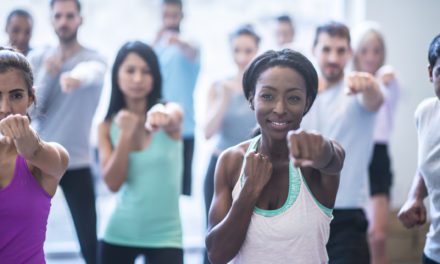Some people were really just born to run. When you’re sitting at a red light, and you see a runner glide by with such ease—long, smooth strides that look more innate than walking—it can make you cringe. Because some of us weren’t born to run. But that doesn’t mean we can’t.
Committing yourself to running for exercise and fitness can be daunting, especially because it can feel truly unnatural and uncomfortable in the beginning. But if you can push through that, it can be so worth it. “Running is the most efficient and most convenient way to get fit, lose weight, reduce stress, and improve your quality of life,” says Jennifer Van Allen, author of The Runner’s World Big Book of Marathon and Half-Marathon Training and The Runner’s World Big Book of Running for Beginners. “It’s free, and you can do it any time in any place; no special skill, pricey membership, or equipment—aside from a good pair of running shoes—is required.”
But there’s no doubt about it, taking those first steps can be terrifying—especially if you haven’t been exercising on a regular basis. “It’s easy to stall out before you even get out of the gate by worrying about what other people will think, being afraid of how uncomfortable running will feel, and being overcome by your own doubts,” she says.
But with the right approach, Van Allen says most of us can be successful at running, presuming your general health and the right pair of running shoes. Here’s her game plan to get you moving in the right direction.
See the Doc
If you’re over 40 or have a family history of heart disease or other health problems, see a doctor before you start a regular exercise program.
Go Shopping
It may seem like an unnecessary expense, but a good pair of running shoes (or sneakers, if you’re from Pennsylvania)—which can cost around $120—is a smart investment in hundreds of miles of pain-free running. Worn-out or ill-fitting shoes are a leading cause of injuries. Go to a specialty running store where a salesperson can help you find the shoes that offer the right support and fit for your feet. These stores can be intimidating, but more than likely you’ll be surprised to find people who are happy to help you and answer all your questions.
Start With Walking
Though some people dismiss “walk” as a four-letter word, it is the most effective way to develop the fitness you need to start running comfortably—without getting hurt. Walking puts your legs and arms through the same general range of motion as running but without the same impact on your bones and joints. Plus it gives you an opportunity to explore convenient, safe, traffic-free routes, which will become important as you get into a routine. It helps you steer clear of injury. When you’re running, at some point both feet come off the ground at the same time, and when you land, the impact can be up to two to three times your body weight. But when you’re walking, one foot is on the ground at all times. That drastically reduces the impact on your bones and joints compared with running.
Time Is What Matters
Don’t worry about your pace or miles covered when you’re just starting out. Just focus on building overall fitness—and making exercise a habit. The main health benefits, such as lower risk of cardiovascular disease, diabetes, and hypertension, result from the time you consistently spend elevating your heart rate. It doesn’t matter how many miles you cover while you’re out. At first, just focus on building up to 150 minutes of exercise per week—that’s about 30 minutes of exercise five times per week.
Pace Yourself
Whether you’re walking or running, you want to focus on getting into a rhythm or pace you feel like you could sustain all day. It should feel relaxed. If you’re huffing and puffing, you’re pushing too hard. It’s common to clench up muscles that aren’t involved in running. And that can sap the strength you need for a good workout. So when the going gets tough, do a body scan: Unknit your brow, unclench your jaw, keep your hands relaxed, and breathe.
Tailor Your Running
In your first weeks of running, focus on establishing a routine that you can sustain. Scout out some safe, convenient, traffic-free routes that you can regularly take in all seasons. And give some thought on how to customize your running life to fit your needs, temperament, and lifestyle. Do you prefer to run in the morning, midday, or evening? Would you rather run outside or hit the treadmill? Do you want to run alone, with a buddy, or with a group? There’s no one “right” choice that fits everyone, just the best choice for you. Your preferences and needs will evolve as you gain fitness, progress, and make exercise into a more regular part of your everyday life.
Take It Inside
When it’s icy and dark outside, the treadmill can be a great way to squeeze in a workout. It’s also ideal because you don’t have to worry about obstacles like cars and curbs that you do outside. That said, there are some steps you’ll need to take to get fit on the treadmill without getting hurt. Be sure to walk or run at a pace you can comfortably sustain. As you tire, lower your speed or the incline. If you can’t keep up with the treadmill without grabbing the handrails, you’re going too fast. Holding on to the handrails can throw off your stride and create a twisting motion, which can lead to injuries. And when you are ready to transition from the treadmill to the outdoors, do so carefully. Too quick a transition can lead to injury. Outside, your calf muscles have to work harder to propel you forward; so do the smaller stabilizer muscles in the joints and ankles. On your first outside run, start with 10 minutes, and add 5 minutes the next week. Continue to build gradually.









